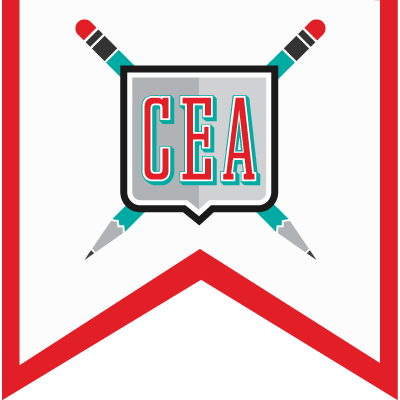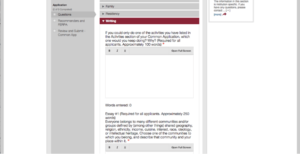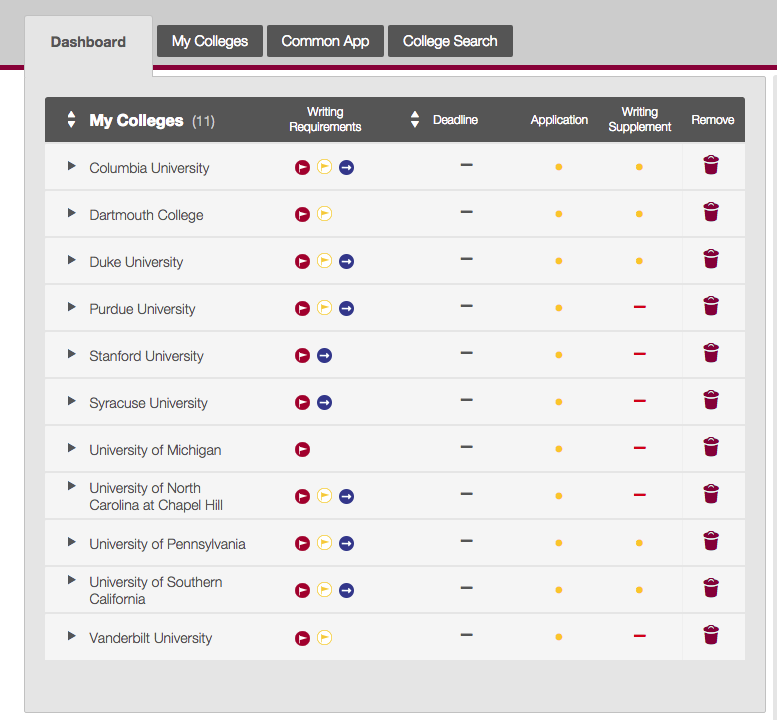What Students Need to Know About the 2015-16 Common App (It’s Here and It’s Better!)
It’s the moment we’ve all been waiting for.
The 2015 Common Application went live this past Saturday in the wake of much anticipation. Though we have known certain details about this year’s Common App essays since April (the prompts received a light makeover, students have gained the ability to print preview the essay during drafting, and each school can decide whether to require the essay portion), an air of mystery and a light skepticism usually surround the release of the Common App’s annually-tweaked online interface. What will be confusing for us this year? Will submissions actually work? WHERE WILL WE FIND THE ESSAYS?
We’ve twiddled every new knob and button and are here to take you through the Good, the Meh and the Ever-Consistent elements of this year’s Common App.
What about the 2015-16 Common App is awesome?
1. The writing requirements are clearly marked. The Common App has finally taken a bit of mercy on all of our souls, adding a “Writing Requirements” tab right on the Dashboard. Click on any school on your list and you will see a quick guide to the institution’s “Personal Essay,” “Member Question” and “Supplemental Writing” requirements:
What is the difference between Member Questions and Writing Supplements? No one knows for sure (the schools certainly haven’t agreed), which may create some additional confusion when you’re hunting for school-specific essays (more on this later). But we’re just thrilled that if there is a requirement buried somewhere in this application so common, we know where to look for it.
And no more guessing whether the schools you’re applying to have required essays or not. Students can easily identify the presence of essays in each school’s application and gauge their requirement level with the help of some nifty colored icons. The red flag means STOP HERE AND WRITE THIS ESSAY. The white flag means SURRENDER! THIS ESSAY ISN’T REQUIRED, BUT YOU SHOULD STILL PROBABLY WRITE IT! (At least in our opinion.) And the blue flag means FIGURE OUT WHAT I MEAN! I MEAN SOMETHING DIFFERENT EVERY TIME! (It’s the “additional information” cue.)
Since this is the first year the Common App’s personal statement will be optional, its inclusion determined by each individual school, this is an incredibly useful feature and will take a lot of confusion out of the search and identification process. (Though, as we mentioned, even if the Common App essay isn’t required, if you’ve written it, submit it. If you haven’t written it – write it! Every opportunity you have to express yourself in your own voice to an admissions officer is one you should take.)
2.The drafting window is expandable. No more feeling like you’re trying to shove a novella into a one-inch column during the drafting process. Students now have the opportunity to write their essays in “full screen mode,” which comfortably mimics a typical word processing experience. Just click the “Full Screen” button in the top corner of the essay box…
…and the window expands. ISN’T IT BEAUTIFUL?
It should be noted that, despite this improved interface, it is never a good idea to draft your essay directly in the Common App’s essay windows. Nothing is as reliable as Google Docs or good ol’ Microsoft Word for REGULARLY SAVING your work (not to mention the added feature of the never-perfect but still helpful spellcheck). We love you Common App, but we still don’t trust you. We know people who have been burned by you before. Use this fancy new widescreen to survey your essay before you hit the submit button, but do all your drafting in the apps you have come to know and trust.
3. The prompts really work. We knew this would be the case when they were unveiled earlier this year, but our preliminary work with our 2015-2016 applicants has already proven that these questions are winners. They’re both broad and inspiring. They create opportunities for students to write about achievements or tell smaller personal stories. Think we’re crazy? Well, we made you a guide that should change your mind. But overall, we anticipate some fantastic essays in response to the prompts this year.
What about this year’s app is Meh?
Supplemental Questions are still hiding from us! Just like last year, schools can categorize written requirements as “Member Questions” OR “Writing Supplements.” Student should be diligent in checking both areas for required writing components. For example, Dartmouth’s supplemental essay is listed in the “Member Questions” section under the “Writing” subhead.
What’s exactly the same?!
1. The style is simple. Just like last year, the only style tools students have access to are bold, italics and underline. Paragraphs must be separated by skipped lines, not indicated by indentations. You can’t get hung up on format when your choices are so limited. It’s all about content.
2. The Additional Info Essay is still around. The Additional Info section still provides an opportunity for students to complete another essay in addition to the personal statement. Some may feel tempted to use it to explore another random subject, but students should use it sparingly. This space is most useful for students whose high school career has been affected by a major life event or circumstance and who don’t want to use the personal statement to tell that story. The instructions don’t make this totally clear, so allow us to provide our own rewrite: unless you have something crucial to add or explain – and there is absolutely NOWHERE else on the application for you to write about it – you should skip this essay.
3. Students are limited to 20 schools. Sorry to all those students out there who were dying to apply to 50 . You can apply to 20 schools via the Common App and no more. While we’re sure the Common App has their own reasons for this, we like to thing they set the limitation to save your sanity.
Of course, no rollout is going to be perfect. The first time we tried to paste a few sentences into the Common App’s window, we received a “please shorten” alert for our paragraph on 92 words. (The essay has a recommended length of 250-650 words.) *Note: This was fixed the following day. As creators of a brand new web-based product, we feel for the Common App. No launch is without its hiccups and these features are sure to be smoothed out in the coming days/weeks. Perhaps these bugs are even a good thing, forcing students to sit with their work a bit longer before pressing the submit button. No one loves an early submission of an application more than I do, but it’s only Aug 1. You’ve got time. Use it.
















